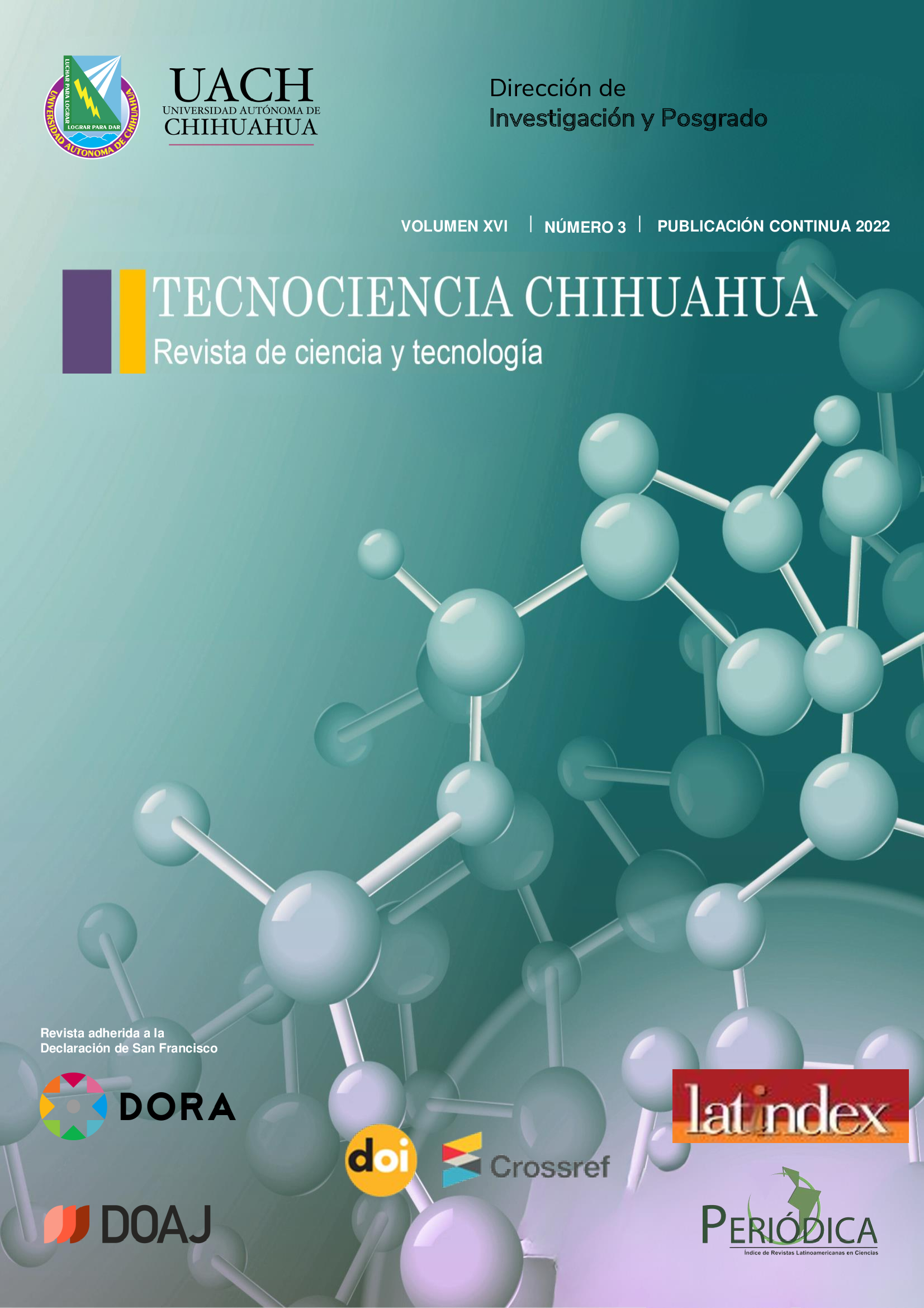Interrelaciones en biomasa final de plántulas de fresa (Fragaria x ananassa Duch.) ‘Festival’ en un sistema hidropónico vertical
Final biomass interrelation of ‘Festival’ strawberry plantlets (Fragaria x ananassa Duch.) in a hydroponic vertical system
DOI:
https://doi.org/10.54167/tch.v16i3.991Palabras clave:
SPAD, sistemas verticales de fresa, propagación vegetativa de fresa, Fragaria x ananassaResumen
Los estudios de relación fuente-demanda dentro del estolón de (Fragaria x ananassa Duch.) son esenciales para configurar sistemas eficientes de producción de plántula en estolones colgantes. Esta investigación analiza, por medio de regresiones, la interrelación de peso seco de raíz y hoja de las plantas madre e hija dentro del corredor. Plantas de fresa ‘Festival’ se plantaron en abril de 2018 en una canaleta elevada a 1.7 m. Después de 239 días, se eligieron al azar 16 plantas con cinco corredores y con al menos cuatro plántulas por corredor. Se determinó el peso seco de raíz, corona y hoja; se realizaron análisis de regresión. Los coeficientes de determinación mostraron un efecto positivo de la raíz de la planta madre sobre el peso de la corona de las plántulas 1, 2, y 3 (R2 > 0.5), pero no de su aparto fotosintético (R2 < 0.07). También, el aparato fotosintético de la plántula tres es importante para el peso de las coronas de todas las plántulas en el corredor (R2 > 0.71). Como conclusión, el enraizamiento de la tercera plántula en el corredor sería importante para incrementar el número de plántulas de buena calidad en un sistema hidropónico de estolones colgantes.
Descargas
Citas
Bartczak, M., J. Lisiecka & M. Knaflewski. 2010. Correlation between selected parameters of planting material and strawberry yield. Folia Horticulturae 22(1): 9-12. https://doi.org/10.2478/fhort-2013-0144
Choi, J.M., J.Y. Park & M.K. Yoon. 2010. Impact of physico-chemical properties of root substrates on growth of 'Seolhyang' strawberry daughter plants occurred through bag culture of mother plants. Horticultural Science & Technology 28(6): 964-972. https://koreascience.kr/article/JAKO201122350105511.page
Durner, E.F., E.B. Poling & J.L. Maas. 2002. Recent advances in strawberry plug transplant technology. HortTechnology 12(4): 545-550. https://doi.org/10.21273/HORTTECH.12.4.545
Kadir, S., E. Carey & S. Ennahli. 2006. Influence of high tunnel and field conditions on strawberry growth and development. HortScience 41(2): 329-335. https://doi.org/10.21273/HORTSCI.41.2.329
Macías-Rodríguez, L., E. Quero & M.G. López. 2002. Carbohydrate differences in strawberry crowns and fruit (Fragaria× ananassa) during plant development. Journal of Agricultural and Food Chemistry 50(11): 3317-3321. https://doi.org/10.1021/jf011491p
Mattner, S.W., C.B. Horstra, M. Milinkovic, P.R. Merriman & F.C. Greenhalgh. 2017. Evaluation of soilless systems for strawberry transplant production in Australia. ISHS Acta Horticulturae 1176: 53-64. https://doi.org/10.17660/ActaHortic.2017.1176.8
Nhut, D.T., T. Takamura, H. Watanabe, K. Okamoto & M. Tanaka. 2003. Responses of strawberry plantlets cultured in vitro under superbright red and blue light-emitting diodes (LEDs). Plant Cell, Tissue and Organ Culture 73: 43-52. https://doi.org/10.1023/A:1022638508007
Paranjpe, E.V., D.J. Cantliffe, E.M. Lamb, P.J. Stoffella & C. Powell. 2003. Winter strawberry production in greenhouses using soilless substrates: an alternative to methyl bromide soil fumigation. Proceedings of the Florida State Horticultural Society 116: 98-105. https://kipdf.com/winter-strawberry-production-in-greenhouses-using-soilless-substrates-an-alterna_5ad2523a7f8b9a363c8b4639.html
Paranjpe, A.V., D.J. Cantliffe, P.J. Stoffella, E.M. Lamb & C.A. Powell. 2008. Relationship of plant density to fruit yield of ‘Sweet Charlie’ strawberry grown in pine bark soilless medium un a high-roof passively ventilated greenhouse. Scientia Horticulturae 115(2): 117-123. https://doi.org/10.1016/j.scienta.2007.08.009
Pérez de Camacaro, M., M. Ojeda, N. Mogollón & A. Giménez. 2016. Potencial de plantas hijas de fresa cultivar Chandler de diferentes nudos del estolón como material de propagación. Revista Unellez de Ciencia y Tecnología 34: 1-8. http://revistas.unellez.edu.ve/index.php/ruct/article/view/255
Savini, G., V. Giorgi, E. Scarano & D. Neri. 2008. Strawberry plant relationship through the stolon. Physiologia Plantarum 134 (3): 421-429 https://doi.org/10.1111/j.1399-3054.2008.01145.x
Shi, X., R. Hernández & M. Hoffmann. 2021. Timing of stolon removal alters daughter plant production and quality in the ever-bearing strawberry ‘Albion’. HortScience 56(6):650–656. https://doi.org/10.21273/HORTSCI15624-20
Steiner A.A. 1984. The universal nutrient solution. In: Proceedings 6th International Congress on Soilless Culture. Wageningen, The Netherlands. pp:633-650.
Takeda, F., S.C. Hokanson & J.M. Enns. 2004. Influence of daughter plant weight and position on strawberry transplant production and field performance in annual plasticulture. HortScience 39(7): 1592-1595. https://doi.org/10.21273/HORTSCI.39.7.1592
Torres-Quezada, E.A., L. Zotarelli, V.M. Whitaker, B.M. Santos & I. Hernandez-Ochoa. 2015. Initial crown diameter of strawberry bare-root transplants affects early and total fruit yield. HortTechnology 25(2): 203-208. https://doi.org/10.21273/HORTTECH.25.2.203.
Treder, W., A. Tryngiel-Gac & K. Klamkowski. 2015. Development of greenhouse soilless system for production of strawberry potted plantlets. Horticultural Science (Prague) 42: 29-36. https://doi.org/10.17221/102/2014-HORTSCI
Türkben, C. 2008. Propagation of strawberry plants in pots: effect of runner order and rooting media. Journal of Biology and Environmental Science 2(4): 1-4. https://uludag.edu.tr/dosyalar/jbes/4/1turkben.pdf
Walter, M., C. Snelling, K.S.H. Boyd-Wilson, G. Williams & G.I. Langford. 2005. Evaluation of organic strawberry runner production. HortTechnology 15(4): 787-796. https://doi.org/10.21273/HORTTECH.15.4.0787
Yamasaki, A. 2013. Recent progress of strawberry year-round production technology in Japan. Japan Agricultural Research Quarterly 47(1): 37-42. https://doi.org/10.6090/jarq.47.37
Publicado
Cómo citar
-
Resumen319
-
PDF120
-
HTML7

















